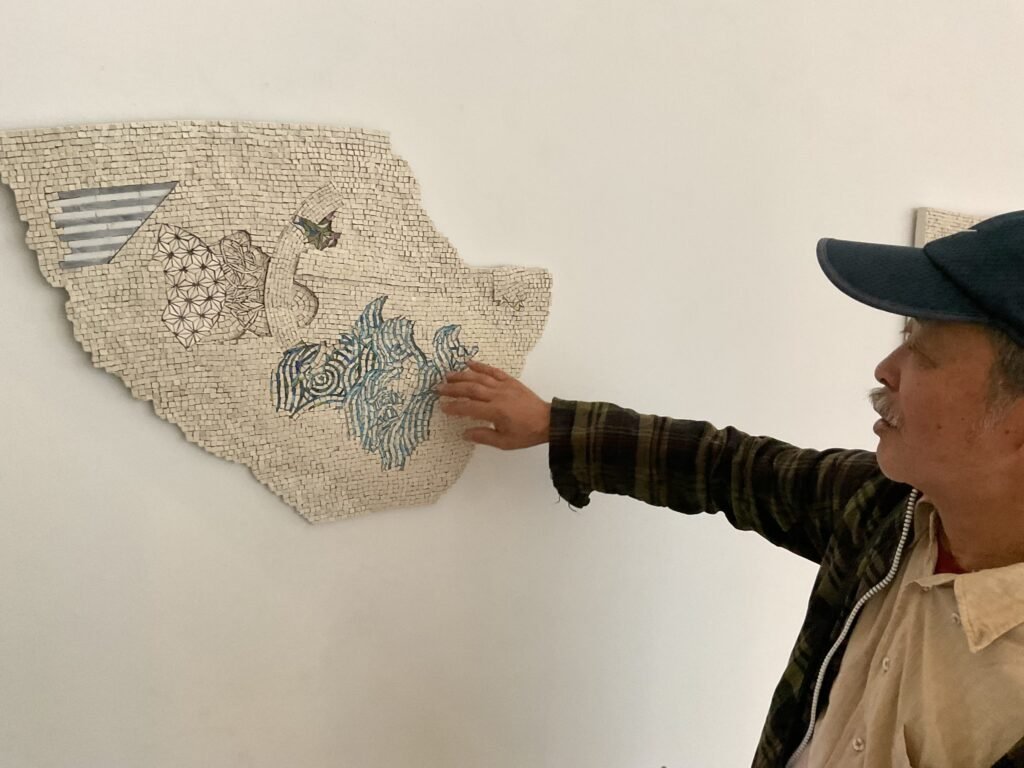EDGEWATER — Chicago is well known for pioneering achievements in the arts: The city revolutionized architecture with the birth of the skyscraper; it served as the original Hollywood, producing landmark silent films; and it played a vital role in modern music, nurturing first the blues and then house genres.
But the city’s role in moving mosaic art forward is one of Chicago’s mostly unsung cultural accomplishments.

The Chicago Mosaic School, 1127 W. Granville Ave., is trying to change all that. The establishment is North America’s first and only nonprofit mosaic art school, established in 2005 — along with its exhibiting arm, the Gallery of Contemporary Mosaics, which occupies the institute’s handsome storefront space.
As testimony to the institution’s goal to elevate the art form globally, the gallery just unveiled its latest group exhibition, “Perspectives from Japan,” running through July 12.
As the title makes plain, “Perspectives” showcases works by eight artists from the Land of the Rising Sun. One of them is master mosaicist Toyoharu Kii, who has earned international renown for his singular style: monochromatic pieces made entirely of white marble.
Kii, who turns 72 in June, lives in a Tokyo suburb, but he’s traveled to Chicago once or twice annually for the past dozen years to teach at the Mosaic School. (His work can also be found in the Bucktown gallery Pagoda Red.)
“He loves Chicago and feels at home here,” Mosaic School founder Karen Ami told Block Club. In addition to mentoring local students, “he always goes to the Art Institute and has a few Chicago hot dogs!”

Kii and Ami met in 2011 after years of email communication. “I was fascinated by his work,” she said. “We have many friends in common from around the world, and we have exhibited together in the states and overseas.”
One of the things they bonded over was the challenge to work in a medium that doesn’t get the respect they think it deserves. “When I talk to the artists of other countries,” Kii told Block Club during an interview at the gallery, “they say the same thing as [I do]: People think mosaics is childish play, or that art critics don’t care about us.”
Ami agrees that the general public and even some in the art world make assumptions about their work: that they are generally for large public-art murals on the sides of buildings, or reserved in the home for bathroom backsplashes. Mosaic art, she said, “can be all of those things by common definition, but what we are doing at CMS — and what artists like myself and Kii practice — is a contemporary fine-art expression with mosaic.”
Kii explained that he was always drawn to art — “I always loved drawing when I was a child, often imitating cartoons” — so he enrolled at the Tokyo National University of Fine Arts in the 1970s to study oil painting. But he soon had a change of heart about his chosen medium: “With oil painting, I couldn’t have imagination. I couldn’t find my place in this world,” he said.
“One day, the school offered us the chance to try other materials, like stained glass. I chose mosaics, and I felt something,” he continued. “I loved to cut stones, and I thought I could do something original with mosaics that I couldn’t do with oil painting.”
After graduating, he moved to Florence because “Italy is the home country of mosaics.” He studied there for two years before moving back home, eventually establishing his own studio.

Kii revealed that he made mosaics with color until around 2000, when he switched almost exclusively to a monochromatic palette. “I love movement of tesserae,” he said, referring to the individual pieces of stone or glass that combine to make the image. “But with color, you cannot see the movement and undulations very well. So I like to make white mosaics, always using Italian marble.”
His pieces in “Perspectives from Japan” stand out from most of the other artists’ work for precisely that reason — although he very recently started incorporating small bits of other materials and hues.
Describing two small ivory-hued mosaic tiles he made one month ago, both of which contain gold highlights, he noted, “they are angels with wings.”
“We have damages in our minds and bodies, and when we pass away, we go back to the sky to repair ourselves, he said. “These golden parts — it’s damage to our bodies and souls. You know kintsugi, when a ceramic bowl is broken, and then repaired with gold? I tried kintsugi here.”
Ami said that Kii was among the contemporary artists to have “taken this art form into their own individual and specific language.” Ki, she said, “continues to explore mosaics and push new boundaries.”
“His choice to use mainly white marble to contrast his tesserae is aesthetically unique in the art world,” Ami said.
“Perspectives from Japan” runs through July 12 at the Gallery of Contemporary Mosaics, which is open to the public six days per week. Visitors can also check out the work of Kii and other artists Sunday, June 1, during the school’s annual indoor/outdoor Mosaic Fest. More information is available on the gallery website.
Listen to the Block Club Chicago podcast:

